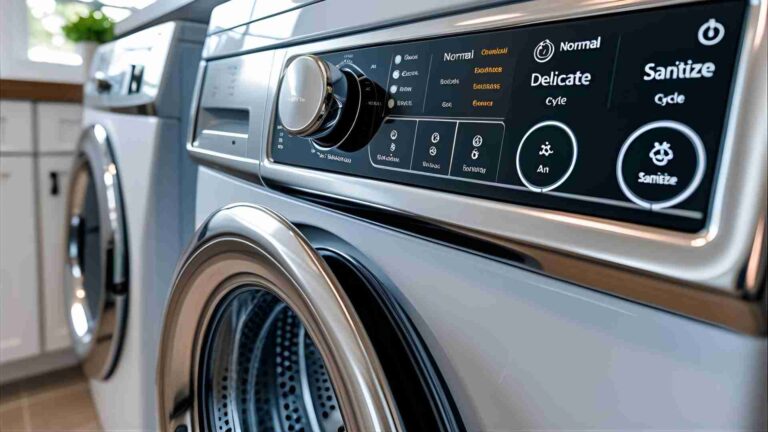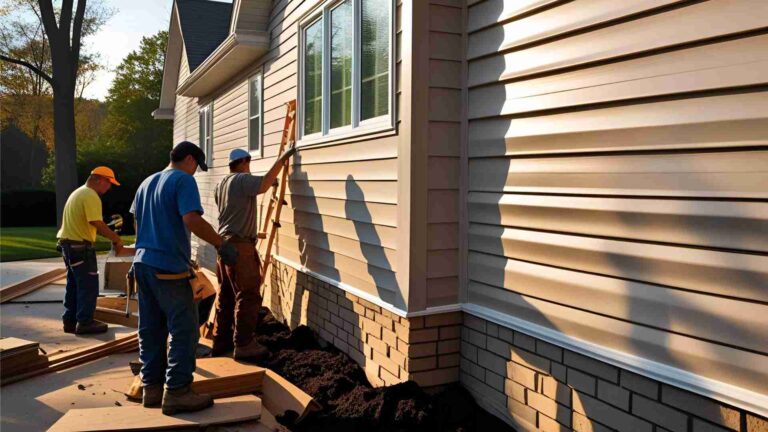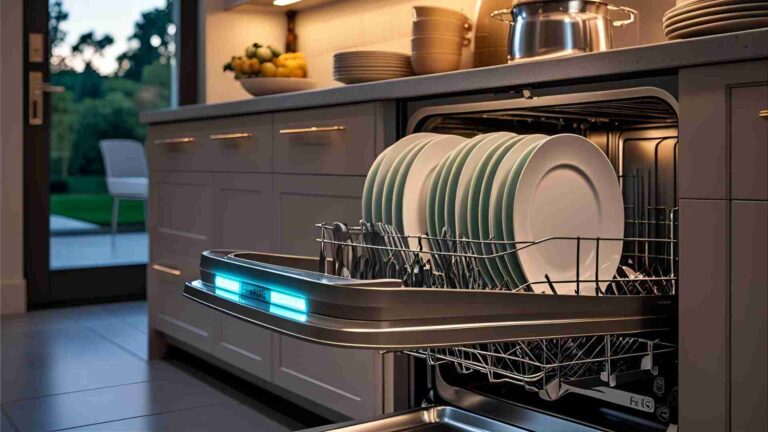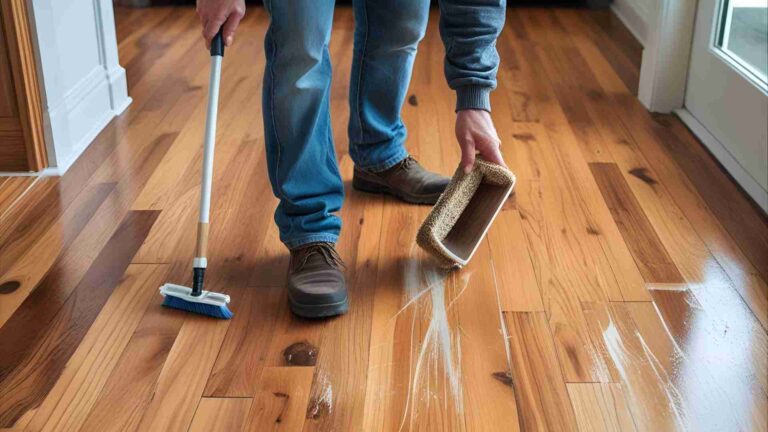9 Easy & Simple Ways to Stop Door Slamming Shut
Discover 9 simple ways to stop doors from slamming shut. Learn why doors slam and explore practical solutions like door closers, felt pads, and more for a quieter home.
A slamming door can be more than just an annoyance—it can startle you, wake a sleeping baby, or even cause damage to the door and frame over time. Whether it’s your front door rattling the entire house or an interior door closing with a loud bang, the issue is often caused by air pressure differences, faulty hinges, or structural imbalances. Fortunately, there are straightforward and effective solutions to stop doors from slamming shut, many of which are affordable and easy to implement. This comprehensive guide explores nine practical ways to prevent door slamming, along with insights into why it happens and how to address it for a quieter, safer home.
Why Do Doors Slam Shut?
Before diving into solutions, it’s essential to understand the root causes of door slamming. Here are the primary reasons why some doors close softly while others slam loudly, even when closed gently:
1. Air Pressure Differences
Air pressure is a common culprit behind slamming doors, especially in homes with open windows, exhaust fans, or poor sealing. When air moves from a high-pressure area to a low-pressure one, it creates drafts that can push or pull a door shut with force. For example, in a small room like a bathroom, air pressure builds up as the door closes, creating resistance that results in a soft close. In contrast, larger spaces or areas near exterior doors, like a condo’s front door, allow air to escape more easily, leading to less resistance and a louder slam.
In larger buildings, such as condos or commercial spaces, deliberate air pressure designs can exacerbate the issue. Common areas like hallways are often pressurized to contain smoke in case of a fire, which can cause exterior doors to slam due to the pressure differential. Negative pressure, where more air is extracted than introduced, can also pull doors shut unexpectedly.
2. Irregular or Warped Doors
A door that’s warped or irregularly shaped may not fit properly in its frame, causing it to hit the frame unevenly and produce a loud bang. Warping can occur due to humidity, age, or poor-quality materials, especially in hollow-core doors commonly used in interiors. Heavy doors, like those used for exterior entrances, may slam more forcefully due to their weight.
3. Faulty or Loose Hinges
Worn, loose, or misaligned hinges can cause a door to close improperly, leading to slamming. If hinges are not level or the screws are loose, the door may not hang correctly, making it prone to sudden closure. Spring hinges, sometimes used on exterior doors, can also apply excessive force if not adjusted properly.
4. Structural Imbalances
Over time, a building’s foundation may settle, causing door frames to become unlevel. This misalignment can make doors close on their own or slam shut, especially if the door is not perfectly vertical in the frame.
5. External Factors
Open windows, running air conditioning, or exhaust fans can create drafts that move doors. In condos or apartments, hallway ventilation systems may contribute to air pressure changes that affect door movement.
Understanding these causes helps pinpoint the best solution for your specific situation. Below, we outline nine effective methods to stop doors from slamming, ranging from simple DIY fixes to more advanced installations.
9 Ways to Stop Doors From Slamming Shut
1. Install Felt Pads
Felt pads are a simple, cost-effective solution to reduce the impact and noise of a slamming door. These small, self-adhesive pads, typically used to protect furniture, can be placed on the door frame or the door’s edge to cushion the impact. By absorbing the force of the door hitting the frame, felt pads minimize noise and prevent damage.
How to Install Felt Pads:
- Clean the door frame or door edge to ensure proper adhesion.
- Place 2–3 felt pads along the strike plate and the top and bottom edges of the frame where the door makes contact.
- Test the door to ensure the pads reduce noise without interfering with closure.
Cost: $2–$10 for a pack of felt pads, available at hardware stores or online retailers like Amazon.
Pros:
- Inexpensive and easy to install
- Discreet and blends with most door frames
- Reduces noise and protects the door and frame
Cons:
- May need replacement over time due to wear
- Less effective for heavy doors or strong drafts
2. Use Foam Weatherstripping
For heavier doors or situations where drafts are a significant issue, foam weatherstripping is a sturdier alternative to felt pads. Weatherstripping seals gaps around the door, reducing airflow and cushioning the door as it closes. This not only prevents slamming but also improves energy efficiency by minimizing drafts.
How to Install Foam Weatherstripping:
- Clean the inside edges of the door frame to remove dust or debris.
- Measure and cut the foam weatherstripping to fit the top and sides of the frame.
- Peel and stick the adhesive side of the weatherstripping to the frame, pressing firmly to secure it.
Cost: $5–$15 for a roll of foam weatherstripping, available at Home Depot, Lowe’s, or online.
Pros:
- Durable and effective for heavy doors
- Reduces drafts and improves insulation
- Easy to install without tools
Cons:
- May require periodic replacement
- Improper installation can affect door closure
3. Inspect and Tighten Door Hinges
Loose or worn hinges are a common cause of slamming doors. Tightening or replacing hinges can ensure the door hangs correctly and closes smoothly.
How to Check and Fix Hinges:
- Open the door to a 90-degree angle and place a level against the latch side to check for plumb.
- Tighten loose hinge screws using a screwdriver. Avoid overtightening, as this can damage the door or frame.
- If hinges are worn or damaged, replace them with new ones compatible with your door type (e.g., standard or spring hinges).
- For spring hinges, adjust the tension using a screwdriver or Allen key, following manufacturer instructions or YouTube tutorials.
Cost: $10–$30 for replacement hinges; free if only tightening is needed.
Pros:
- Addresses the root cause of hinge-related slamming
- Relatively simple fix for DIY enthusiasts
- Long-lasting solution
Cons:
- May require professional help for complex hinge adjustments
- Replacement hinges can be costly for high-end doors
4. Install a Pneumatic or Hydraulic Door Closer
Pneumatic or hydraulic door closers are highly effective for preventing slamming, especially on exterior or heavy doors. These devices use air or oil pressure to control the door’s closing speed, ensuring a slow, smooth closure.
How to Install a Door Closer:
- Choose a door closer compatible with your door’s weight and type (interior or exterior).
- Follow the manufacturer’s instructions to mount the closer on the door and frame, typically at the top.
- Adjust the closing speed using the provided screws to achieve the desired resistance.
Cost: $20–$100, depending on the brand and model (e.g., Wright Products or Prime-Line).
Pros:
- Highly effective for preventing slams
- Adjustable for customized closing speed
- Enhances safety and security (e.g., fire-rated doors)
Cons:
- Installation may require professional assistance
- More expensive than other solutions
5. Use a Door Stopper
A door stopper is a simple, low-cost solution to prevent doors from closing fully, thus eliminating slamming. Available in rubber, foam, or metal, door stoppers can be wedged under the door or mounted on the floor or wall.
Types of Door Stoppers:
- Wedge Stoppers: Placed under the door to hold it open or partially closed.
- Floor-Mounted Stoppers: Screwed into the floor to stop the door at a specific point.
- Wall-Mounted Stoppers: Protect walls from damage when doors are opened forcefully.
Cost: $5–$20, depending on the type and material.
Pros:
- Extremely easy to use and install
- Affordable and widely available
- Suitable for temporary or permanent use
Cons:
- Wedge stoppers require manual placement
- May not be ideal for frequently used doors
6. Install Pinch Guards
Pinch guards are soft, C-shaped devices that prevent doors from closing fully, reducing the risk of slamming and protecting fingers, especially in homes with children. They slide onto the door’s edge and stop it from latching.
Recommended Product: BYETOO Pinch Guard ($10–$15 for a pack of 4–6).
Pros:
- Child-safe and prevents injuries
- Easy to install and remove
- Inexpensive and effective for noise reduction
Cons:
- May not suit all door aesthetics
- Less effective for heavy exterior doors
7. Add a Door Sweep (Weatherstripping)
A door sweep, or weatherstripping attached to the bottom of the door, reduces airflow and slows the door’s movement. This is particularly effective for drafty homes or exterior doors.
How to Install a Door Sweep:
- Measure the door’s width and cut the sweep to size.
- Attach the sweep to the bottom of the door using adhesive or screws, ensuring it brushes lightly against the floor.
- Test the door to ensure smooth operation without excessive resistance.
Cost: $10–$25, available at hardware stores or online.
Pros:
- Reduces drafts and noise
- Durable for long-term use
- Improves energy efficiency
Cons:
- Installation may require tools
- May not fully prevent slamming in high-pressure environments
8. Use Anti-Slam Hinges
Anti-slam hinges, also known as soft-close hinges, are designed to slow the door’s closing speed, preventing slams. These hinges are more complex than standard ones, incorporating a damping mechanism.
Cost: $20–$50 per hinge, depending on the door’s weight and type.
Pros:
- Nearly invisible solution
- Long-lasting and low maintenance
- Ideal for minimalist aesthetics
Cons:
- More expensive than standard hinges
- Installation may require professional help
9. Install Wall-Mounted Door Bumpers
Wall-mounted door bumpers prevent damage when doors are opened forcefully, but they can also reduce noise when doors close by cushioning the impact. These are typically spring-loaded or rubber-tipped devices attached to the wall or baseboard.
Cost: $5–$15 per bumper.
Pros:
- Protects walls and doors
- Easy to install
- Affordable and discreet
Cons:
- Does not prevent slamming when closing
- Limited to specific door configurations
Comparison Table: Solutions to Stop Door Slamming
| Solution | Cost | Installation Difficulty | Effectiveness | Best For |
|---|---|---|---|---|
| Felt Pads | $2–$10 | Easy | Moderate | Light interior doors |
| Foam Weatherstripping | $5–$15 | Easy | Moderate | Heavy doors, drafty homes |
| Tighten/Replace Hinges | $0–$30 | Moderate | High | Misaligned or loose hinges |
| Pneumatic/Hydraulic Closer | $20–$100 | Moderate to Hard | Very High | Exterior or heavy doors |
| Door Stopper | $5–$20 | Easy | High | Temporary or light-duty use |
| Pinch Guards | $10–$15 | Easy | Moderate | Homes with children |
| Door Sweep | $10–$25 | Moderate | Moderate | Drafty homes, exterior doors |
| Anti-Slam Hinges | $20–$50 | Hard | High | Minimalist aesthetics |
| Wall-Mounted Bumpers | $5–$15 | Easy | Low (for closing) | Preventing wall damage |
Chart: Decision Flow for Choosing a Solution
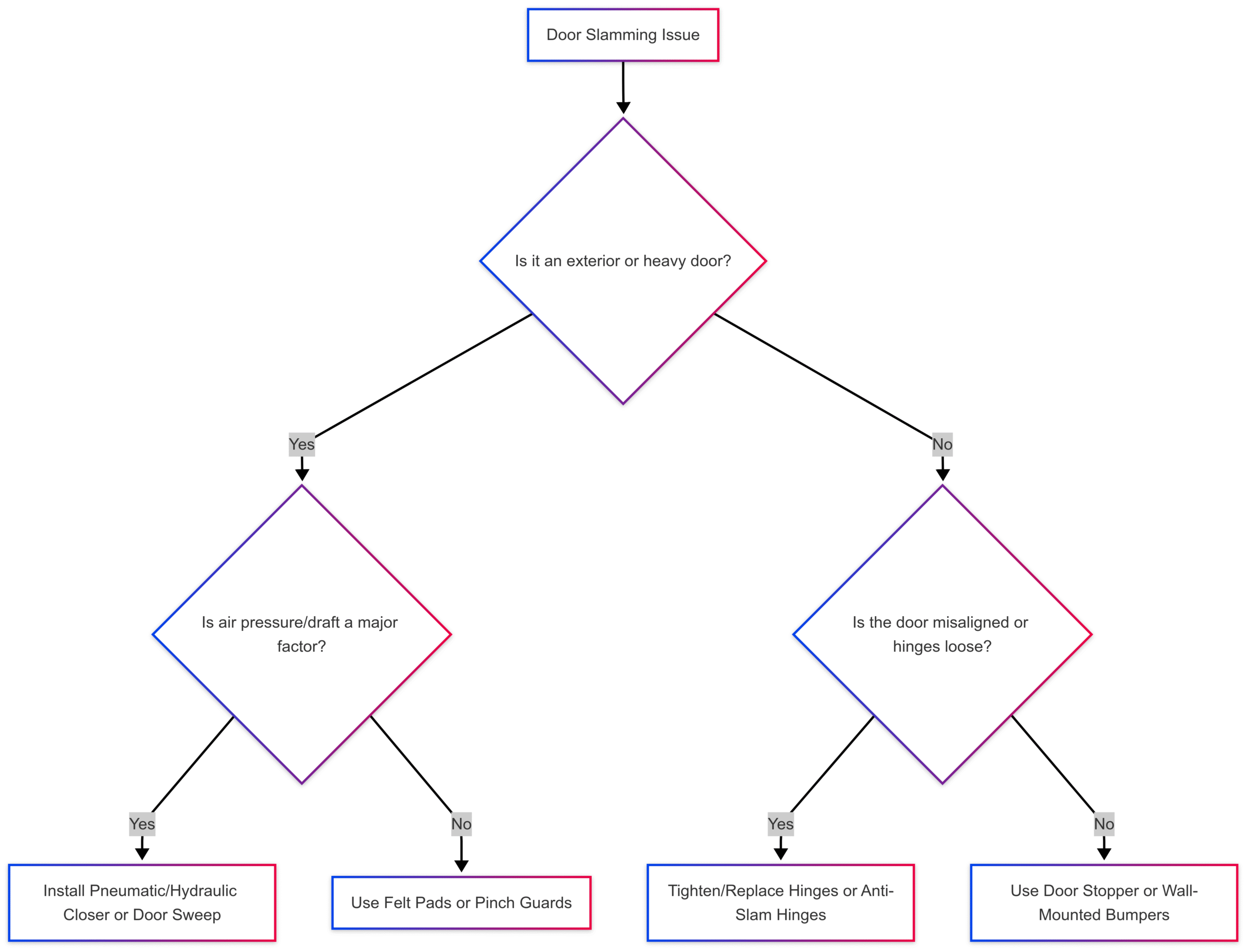
Additional Tips to Prevent Door Slamming
- Address Air Pressure Imbalances: If drafts are a significant issue, consider closing unnecessary windows, sealing gaps with window insulation film, or consulting an HVAC professional to balance your home’s ventilation system.
- Check for Warped Doors: Inspect the door for warping or damage. If warped, replace the door or consult a professional for rehanging.
- Professional Assessment: For persistent slamming in condos or commercial buildings, contact a ventilation expert to evaluate air pressure issues, especially if the building has a pressurized hallway system.
Final Thoughts
A slamming door can disrupt the peace of your home, but with these nine easy solutions, you can eliminate the problem and enjoy a quieter, safer environment. From affordable felt pads and pinch guards to more robust options like pneumatic door closers and anti-slam hinges, there’s a solution for every budget and door type. Start by identifying the cause—whether it’s air pressure, loose hinges, or a warped door—and choose the method that best fits your needs. For complex issues or exterior doors, consider professional installation to ensure long-lasting results.
By implementing one or more of these solutions, you can say goodbye to the startling bang of a slamming door and hello to a more tranquil home. Explore these options at your local hardware store or online, and take the first step toward a quieter living space today.
Please share this 9 Easy & Simple Ways to Stop Door Slamming Shut your friends and do a comment below about your feedback.
We will meet you on next article.
Until you can read, Prevent Messy Paintbrush Drips With A Genius Container Lid Hack

